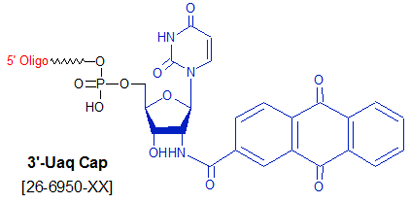
Modification : Uaq Cap (3')
Catalog Reference Number
Category
Modification Code
5 Prime
3 Prime
Internal
Molecular Weight (mw)
Extinction Coeficient (ec)
Technical Info (pdf)
Absorbance MAX
Emission MAX
Absorbance EC
26-6950
Duplex Stability
[Uaq-Cap]
n
Y
N
539.39
8.4
PS26-6950.pdf
-
-
-
| Catalog No | Scale | Price |
| 26-6950-05 | 50 nmol | $253.00 |
| 26-6950-02 | 200 nmol | $253.00 |
| 26-6950-01 | 1 umol | $329.00 |
| 26-6950-03 | 2 umol | $493.00 |
| 26-6950-06 | 5 umol | $1,480.50 |
| 26-6950-10 | 10 umol | $2,628.00 |
| 26-6950-15 | 15 umol | $3,285.00 |
5' and 3' Caps for Increased Duplex Stability.
Pyrene, Stilbene and 3'-Uaq caps favor the formation of stable Watson-Crick duplexes by stacking on the terminal base pair. Melting point increases of over 10 oC per modification can be realized for short duplexes
The caps fit canonical Watson-Crick base pairs and do not stack well on mismatched base pairs. This leads to increased base pairing selectivity at the terminal and the penultimate position of oligonucleotides featuring the caps. Base pairing fidelity is usually low at the termini, where fraying occurs frequently in the absence of caps. The beneficial effects of the caps are also realized when longer target strands are bound, so there is no need for blunt ends for the duplexes formed. The caps, when attached to the terminus of an oligonucleotide, also facilitate purification as their lipophilicity leads to prolonged retention on reversed phase columns or cartridges. Finally, capping of termini may discourage the degradation of oligonucleotides by exonucleases.
3' Uaq Cap
3'-Uaq Cap is available as a cap structure for the 3' of an oligo. It is a Uridine support modified with a 2'-anthraquinone residue and is the most effective oligonucleotide cap known to date. For short hybrid duplexes between DNA probes and RNA target strands, the increase in Tm is up to 18oC and the modification is effective in increasing the Tm of DNA:DNA, RNA:RNA, and DNA:RNA hybrid duplexes. 3'-Uaq Cap also increases probe specificity by depressing the melting point of terminal mismatches.
5' Pyrene Cap
5'-Pyrene cap (Pyrenylmethylpyrrolindol)will produce a cap that is more lipophilic than the trimethoxystilbene. The aromatic stacking moiety is linked to the terminus of the DNA through a more rigid, cyclic linker than in the case of trimethoxystilbene. This feature may prove advantageous for researchers interested in exploiting the special photophysical properties of the pyrenyl substituent. The pyrrolindol linker is stereoregular, leading to a single product that can be readily purified by HPLC. The pyrenyl cap is the lead compound discovered in a recent combinatorial study that evaluated over 40 different caps. The cap proved particularly successful for hybridization probes with a 5'-terminal deoxyadenosine residue. Again, its duplex-stabilizing effect does not require blunt ends. The tertiary amino group can be expected to be protonated at physiological pH, producing a cationic functionality that may help to attract target strands electrostatically. The five membered ring presenting the pyrenyl stacking unit mimics the deoxyribose of natural nucleosides, making duplexes terminating in this cap more similar in shape to unmodified DNA than those capped with the trimethoxystilbene.
Trimethoxystilbene cap
Stilbenes have been successfully employed for covalently bridging the termini of oligonucleotide hairpins. The trimethoxystilbene cap that is the result of a recent study that focused on stilbenes that are covalently linked to only one of the two strands forming a duplex. The three methoxy substituents interact with the 2'-methylene group of the nucleoside in the target strand. Together with the stacking on the terminal base pair, this leads to much-improved mismatch discrimination. The effect is observed for any of the four possible base pairs at the terminus.
Trimethoxystilbene cap increases the signal for the fully complementary target strand when used for hybridization probes immobilized on a glass surface in the form of a DNA microarray. This feature is particularly important for A/T-rich sequences that often cause false negatives. The selective stabilization of neighboring Watson-Crick base pairs helps to suppress cross hybridization that would otherwise lead to stronger false positive results.
References
1. Dogan, Z.; Paulini, R.; Rojas Stutz, J. A.; Narayanan, S.; Richert, C. 5'-Tethered stilbene derivatives as fidelity- and affinity-enhancing modulators of DNA duplex stability. J. Am. Chem. Soc. 2004, 126, 4762-4763.
2. Narayanan, S.; Gall, J.; Richert, C. Clamping down on weak terminal base pairs: oligonucleotides with molecular caps as fidelity-enhancing elements at the 5'- and 3'-terminal residues. Nucleic Acids Res. 2004, 32, 2901-2911.
3. (a) Wu, T.; Burch, E. L.; Bassani, D. M.; Yang, J.-S.; Schneider, S.; Jager, W.; Letsinger, R. L. Hybrid oligonucleotides containing sStilbene units. Excimer fluorescence and photodimerization J. Am. Chem. Soc. 1995, 117, 8785-8792.
(b) Lewis, F.D.; Wu, T.; Zhang, Y.; Letsinger, R.L., Greenfield, S.R.; Wasielewski, M.R. Distance-dependent electron transfer in DNA hairpins. Science 1997, 277, 673-676. (c) Lewis, F. D.; Liu, X.; Wu, Y.; Miller, S. E.; Wasielewski, M. R.; Letsinger, R. L.; Sanishivili, R.; Joachimiak, A.; Tereshko, V.; Egli, M. Structure and photoinduced electron transfer in exceptionally stable synthetic DNA hairpins with stilbenediether linkers. J. Am. Chem. Soc. 1999, 121, 9905-9906. (d) Lewis, F. D.; Wu, Y.; Liu, X. Synthesis, structure, and photochemistry of exceptonally stable synthetic DNA hairpins with stilbene diether linkers. J. Am. Chem. Soc. 2002, 124, 12165-12173.
4. Tuma, J.; Paulini, R.; Rojas Stutz, J. A.; Richert, C. How much pi-stacking do DNA termini seek? Solution structure of a self-complementary DNA hexamer with trimethoxystilbenes capping the terminal base pairs. Biochemistry 2004, 43, 15680-15687
5. Dombi, K. L.; Griesang, N.; Richert, C. Oligonucleotide arrays from aldehyde-bearing glass with coated background. Synthesis 2002, 816-824.
- Uaq Cap (3')
